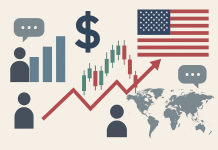Introduction
The Forex market, the world’s largest financial marketplace, is continuously evolving. With billions of dollars traded daily, traders and financial institutions seek advanced methods to analyze trends and make profitable decisions. Traditional technical and fundamental analysis methods, though effective, have limitations in predicting sudden market shifts. However, the rise of Artificial Intelligence (AI) is changing the landscape of Forex trading.
AI-driven market models are revolutionizing the way traders analyze price movements, identify trends, and execute trades. These models use machine learning algorithms, deep learning, and big data analytics to provide more accurate and timely market predictions. This article explores how AI-driven models are transforming the Forex market, their advantages over traditional methods, and what the future holds for AI in Forex trading.
Understanding AI In Forex Trading
Artificial Intelligence in Forex trading refers to the use of algorithms and machine learning techniques to analyze large amounts of market data, identify patterns, and make predictions. Unlike human traders, AI can process vast amounts of information within seconds, making it highly efficient for decision-making.
AI-driven Forex models operate using several key technologies:
Machine Learning and Predictive Analytics
Machine learning algorithms analyze historical market data to identify patterns and predict future price movements. These models continuously learn from new market data, improving their accuracy over time. Predictive analytics allows traders to anticipate trends, volatility, and potential reversals.
Deep Learning for Pattern Recognition
Deep learning, a subset of machine learning, enables AI models to recognize complex patterns in price charts, news sentiment, and economic indicators. These models can differentiate between genuine market trends and short-term fluctuations caused by market noise.
Big Data Processing and Sentiment Analysis
AI models use big data techniques to analyze multiple sources of information, including economic reports, central bank policies, news articles, and social media sentiment. Sentiment analysis helps traders understand how global market sentiment influences currency values.
How AI Models Work In Forex Trading?
AI-driven Forex models follow a structured approach to market analysis and trading decision-making:
Data Collection and Preprocessing
AI models gather vast amounts of data from financial markets, including price charts, economic indicators, interest rates, and geopolitical news. The data is then cleaned and preprocessed to remove inconsistencies, ensuring accuracy in predictions.
Feature Selection and Model Training
AI algorithms identify the most relevant factors influencing Forex price movements. These factors include support and resistance levels, moving averages, Relative Strength Index (RSI), and market volatility. The model is then trained using historical data to recognize correlations and patterns.
Real-Time Market Analysis
Once trained, the AI model analyzes live market data to detect trends and trading opportunities. It monitors currency pairs, identifies breakouts, and provides real-time trading signals to help traders make informed decisions.
Automated Trading Execution
Some AI-driven Forex models are integrated with automated trading systems. These systems execute trades based on AI-generated signals without human intervention, minimizing emotional trading decisions and increasing efficiency.
Advantages Of AI In Forex Market Analysis
AI-driven market models offer several advantages over traditional trading strategies:
Speed and Efficiency
AI can process and analyze large amounts of market data within milliseconds, allowing traders to react to market changes instantly.
Reduced Human Bias
Emotions such as fear and greed often lead to irrational trading decisions. AI eliminates emotional trading, ensuring data-driven and objective decision-making.
Enhanced Accuracy
AI models continuously learn and improve, refining their predictive capabilities over time. This enhances the accuracy of price movement forecasts and reduces trading risks.
24/7 Market Monitoring
Forex markets operate 24 hours a day, making it challenging for human traders to monitor price movements continuously. AI-driven systems can analyze the market round the clock, ensuring traders never miss a profitable opportunity.
Risk Management And Loss Prevention
AI models incorporate risk management strategies by analyzing volatility, market sentiment, and historical trends. They help traders set optimal stop-loss and take-profit levels to minimize losses and maximize gains.
Challenges Of AI In Forex Trading
Despite its advantages, AI in Forex trading comes with challenges:
Data Quality and Reliability
AI models require high-quality, real-time market data for accurate predictions. Inaccurate or delayed data can lead to false trading signals.
Overfitting and Model Dependence
AI models can sometimes “overfit” historical data, meaning they become too reliant on past patterns that may not always repeat. Traders must validate AI-generated signals before executing trades.
Regulatory Concerns
Automated AI trading raises regulatory concerns regarding market manipulation, fairness, and transparency. Financial regulators continue to monitor AI-driven trading systems to ensure compliance.
High Initial Investment
Developing and maintaining AI-driven trading models requires substantial investment in technology, data infrastructure, and expertise. However, as AI technology advances, costs are gradually decreasing.
The Future Of AI In Forex Trading
As AI technology continues to evolve, its role in Forex trading is expected to expand significantly:
AI-Driven Portfolio Management
AI will be used to create diversified Forex investment portfolios, optimizing risk and return based on real-time market conditions.
Quantum Computing in Forex Predictions
The integration of quantum computing with AI will enhance market prediction capabilities, processing complex data at unprecedented speeds.
Blockchain and AI Integration
Blockchain technology can improve data transparency and security in AI-driven Forex trading, reducing fraudulent activities and ensuring fair trading conditions.
AI-Powered Trading Bots
More sophisticated AI trading bots will emerge, capable of executing high-frequency trades with enhanced decision-making algorithms.
Conclusion
AI-driven Forex market analysis represents the future of trading, offering enhanced accuracy, speed, and efficiency. While traditional trading methods still hold value, AI provides a data-driven edge that human traders cannot match. By integrating AI into their trading strategies, Forex traders can gain a competitive advantage in the ever-changing financial markets.
As AI technology continues to develop, its role in Forex trading will only become more significant. Traders who embrace AI-driven models today will be better positioned to navigate the complexities of the Forex market and maximize their profitability.




